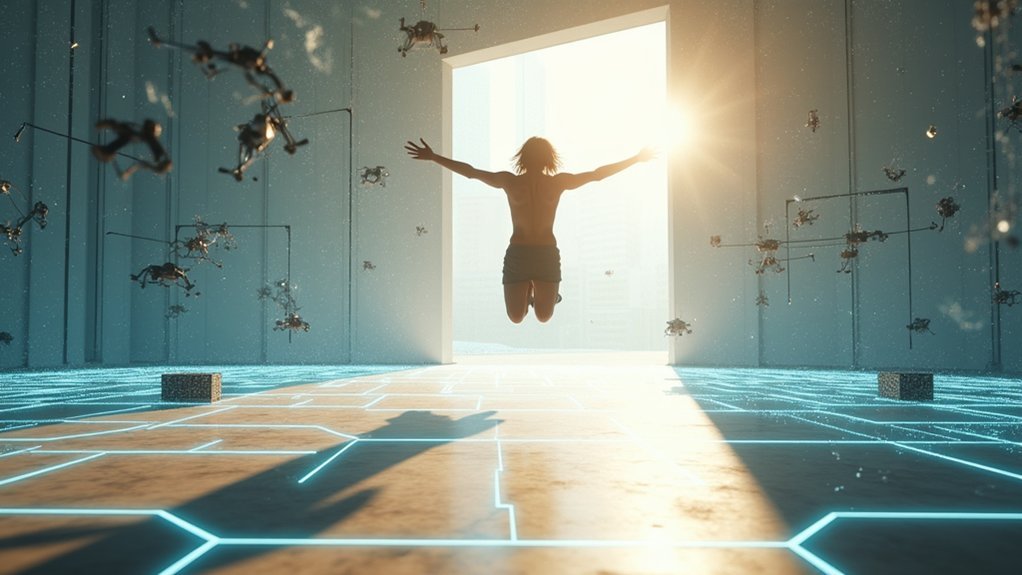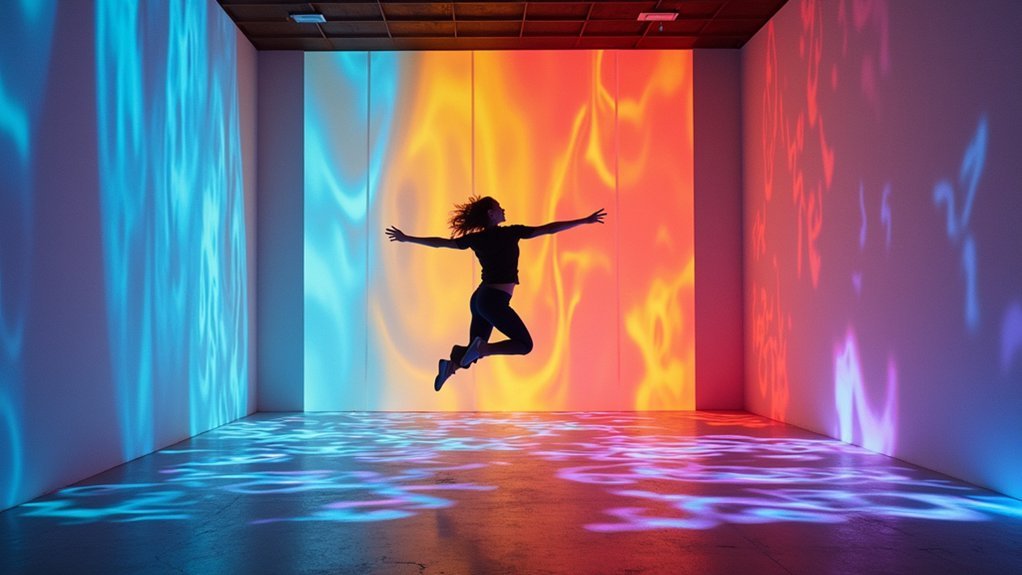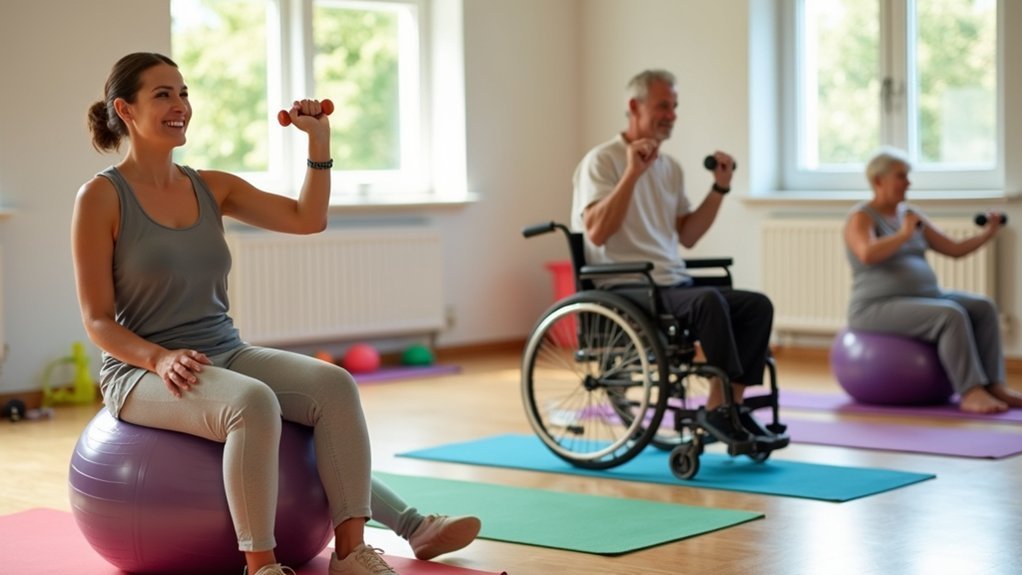You’re experiencing the revolution of room-scale VR tracking that breaks physical boundaries through Six Degrees of Freedom technology. Your headset’s internal cameras and sensors eliminate external hardware constraints, allowing natural movements like walking, ducking, and reaching within virtual worlds. Redirected walking techniques and wireless solutions create illusions of unlimited space, while Guardian systems guarantee safety. Advanced algorithms manipulate spatial perception, transforming confined areas into seemingly endless environments where your body becomes the ultimate controller for unprecedented immersive adventures.
Understanding Movement Freedom in Virtual Reality Environments

While traditional VR experiences confine you to stationary gameplay, room scale tracking transforms your physical space into a gateway for unrestricted virtual exploration.
You’re no longer tethered to a single position, instead gaining Six Degrees of Freedom that lets you walk, duck, reach, and lean naturally within virtual environments.
Your headset’s internal sensors continuously monitor your position, translating every physical movement into corresponding virtual actions.
This creates seamless interaction where you can physically approach objects, peek around corners, or dodge incoming obstacles using your body’s natural motions.
To achieve the best room scale performance, you’ll need at least 2M x 1.5M of clear space.
Proper boundary calibration guarantees accurate tracking, preventing disorientation while maximizing your movement freedom within the defined play area.
The Evolution From Stationary to Mobile VR Experiences
You’ve witnessed VR transform from tethered, stationary experiences that confined you to a chair or small standing area into dynamic systems that track your full-body movements across entire rooms.
This evolution wasn’t instant—breakthrough developments in spatial tracking technology had to overcome significant technical hurdles before room-scale VR became viable for consumer use.
Today’s mobile VR systems like the Oculus Quest represent years of innovation that solved early limitations around external sensors, processing power, and the complex challenge of accurately mapping your movements in real-time.
Early VR Limitations
Before room-scale tracking revolutionized virtual reality, early VR systems trapped users in stationary setups that severely constrained movement and undermined the immersive potential of virtual environments.
These early VR limitations confined you to a fixed position, dramatically reducing your ability to naturally interact with virtual worlds. You couldn’t walk around or explore spaces as you’d in reality, making the VR experience feel artificial and disconnected.
The stationary setups of systems like the original Oculus Rift and HTC Vive required external sensors for tracking, complicating installation and restricting your mobility.
You’d find yourself tethered to specific locations, unable to achieve the truly immersive VR that modern users expect. This fundamental constraint prevented early adopters from experiencing the full potential of virtual reality technology.
Tracking Technology Breakthroughs
Revolutionary breakthroughs in tracking technology transformed VR from restrictive stationary experiences into expansive mobile adventures that let you move naturally through virtual worlds.
Modern VR headset systems now deliver 6DoF tracking, capturing both rotational and translational movements with remarkable precision. You’re no longer tethered to external sensors that limited your range—today’s headsets integrate advanced internal cameras and sensors directly into the device.
These innovations dramatically reduced latency while improving accuracy, enabling you to perform complex movements like dodging, climbing, and running within virtual environments.
Your VR headset can now track every subtle motion within a minimum 2M x 1.5M play area, creating seamless interactions that feel completely natural and immersive without external hardware constraints.
Room-scale Implementation Challenges
While these technological advances opened new possibilities, implementing room-scale VR presents significant hurdles that developers and users must navigate carefully. You’ll encounter multiple obstacles when setting up room-scale tracking systems that can impact your virtual experience.
The primary implementation challenges include:
- Space Requirements – You need a minimum 2M x 1.5M area, which many homes can’t accommodate.
- Tracking Accuracy – Maintaining precise 6DoF tracking becomes difficult with hardware limitations and environmental interference.
- Safety Boundaries – You must carefully trace play areas using controllers to prevent collisions with furniture or walls.
- Hardware Constraints – Your system’s spatial awareness capabilities directly affect room-scale tracking performance and reliability.
These challenges require careful consideration during setup and ongoing maintenance for ideal room-scale experiences.
Technical Foundations of Spatial Tracking Systems
As you step into the world of room-scale VR, sophisticated spatial tracking systems work behind the scenes to translate your physical movements into precise digital actions.
Room-scale VR transforms your physical movements into digital precision through sophisticated spatial tracking systems working seamlessly behind the scenes.
These systems combine internal sensors within your headset with external sensors positioned throughout your play space to monitor your position in real-time.
The tracking capabilities are measured in degrees of freedom. 3DoF systems track only rotational movements—looking up, down, and around.
However, 6DoF systems capture both rotational and translational movements, allowing you to walk, duck, and lean within virtual environments.
Advanced optical tracking and inertial measurement units guarantee millisecond-precise positioning of your headset and controllers.
During calibration, you’ll establish a virtual grid that maps your physical floor height and boundaries, enabling the system to accurately reflect your movements within the minimum 2M x 1.5M play area.
Overcoming Physical Space Limitations Through Technology

You’re no longer confined by your living room’s walls when cutting-edge techniques like redirected walking trick your brain into believing you’re exploring endless virtual landscapes.
Wireless tracking solutions free you from tangled cables, letting you move naturally without worrying about tripping over hardware.
These innovations work together to create infinite virtual worlds that feel genuinely boundless, even when you’re actually pacing within a space smaller than most bedrooms.
Redirected Walking Techniques
When your physical room feels cramped but your virtual world stretches endlessly, redirected walking techniques bridge that gap through clever perceptual manipulation.
You’ll experience the illusion of unlimited space while staying safely within your actual boundaries.
Here’s how redirected walking transforms your VR experience:
- Perceptual distortion – Your path gets subtly manipulated, making you feel like you’re walking straight while actually following curves.
- Optical tracking precision – Advanced systems monitor your exact position to maintain seamless immersion and prevent disorientation.
- Natural movement enhancement – You’ll engage more deeply with virtual environments through authentic walking motions.
- Careful calibration requirements – The system guarantees you won’t collide with physical obstacles while traversing virtual worlds.
This technology effectively eliminates spatial constraints, letting you explore vast digital landscapes naturally.
Wireless Tracking Solutions
Breaking free from stationary sensors and tangled cables, wireless tracking solutions revolutionize how you experience room-scale VR by eliminating physical tethers that once confined your movements.
These advanced systems combine inertial measurement units and optical tracking technology to monitor your position and orientation in real-time across expansive physical spaces.
Multiple cameras and sensors work together, creating seamless immersive experiences while markedly reducing latency. Your movements translate instantly into virtual environments without delays or interruptions.
You’ll appreciate how these wireless tracking solutions support multiple users simultaneously, enabling collaborative experiences and social interactions that weren’t possible with traditional wired setups.
Companies continuously push innovation boundaries, improving range and accuracy. This ongoing development expands virtual reality’s potential across diverse environments, transforming how you navigate and interact within digital worlds.
Infinite Virtual Worlds
While physical rooms impose natural boundaries on movement, infinite virtual worlds emerge through sophisticated algorithms that manipulate your spatial perception within confined areas.
These advanced VR systems create seemingly endless environments where you can explore vast landscapes, sprawling cities, or fantastical domains without ever hitting a wall.
Redirected walking techniques subtly alter your virtual path, making straight lines feel curved while keeping you safely within your physical space.
You’ll experience:
- Seamless navigation through unlimited virtual terrain using 6DoF tracking systems
- Real-time spatial manipulation that bends virtual geometry to match your room’s constraints
- Hybrid environments combining physical props with digital overlays for enhanced immersion
- Adaptive algorithms that dynamically adjust virtual layouts based on your movement patterns
This technology transforms cramped spaces into infinite virtual worlds.
Guardian System Alternatives and Advanced Configurations

Although Meta’s default Guardian system provides solid boundary management for most users, you’ll discover that advanced configurations and alternative solutions can dramatically expand your room-scale tracking capabilities.
Advanced Guardian configurations and third-party tracking solutions can dramatically enhance your Meta VR room-scale capabilities beyond default limitations.
You can access hidden Guardian settings to fine-tune boundary height and sensitivity, creating a more personalized guardian boundary experience that matches your specific environment. When facing persistent tracking issues, clearing your boundary cache often resolves problems and enables smoother custom boundary redrawing.
Beyond Meta’s built-in options, third-party applications offer enhanced room-scale tracking solutions that surpass the default Guardian system’s limitations.
These alternatives provide superior boundary management tools, allowing you to push beyond standard restrictions. You’ll find that customizing sensitivity and size parameters creates a tailored VR experience that maximizes your available play space while maintaining safety protocols.
Redirected Walking Techniques for Infinite Exploration
When you’ve exhausted the possibilities of traditional boundary expansion, redirected walking techniques offer a revolutionary approach to creating infinite exploration within your limited physical space.
This spatial manipulation technology subtly redirects your movements without conscious awareness, enabling you to walk in circles while perceiving linear paths through expansive virtual worlds.
Systems like The VOID demonstrate how redirected walking creates the illusion of infinite space through precise tracking and careful virtual environment adjustments.
You’ll experience continuous movement while remaining safely within your play area’s confines.
Key benefits of redirected walking include:
- Extended engagement duration by eliminating physical space limitations
- Enhanced immersion through seamless spatial manipulation
- Circular movement patterns that feel like straight-line exploration
- Precise tracking systems ensuring safe boundary management
Hardware Requirements for Seamless Room-Scale Implementation
The foundation of effective room-scale VR lies in selecting the right hardware components that work harmoniously to deliver precise tracking and immersive experiences.
You’ll need a minimum 2M x 1.5M play area for ideal movement and immersion. Modern headsets like Oculus Quest and Rift S use internal sensors for tracking, while HTC Vive systems require external sensors.
Your setup must support 6DoF tracking, enabling both rotational and translational movements that enhance immersion. Clear your play area of all obstructions to maintain accurate tracking and prevent boundary issues.
Regular software updates for your headset and applications are crucial for improving tracking performance and resolving boundary-related problems. A clutter-free environment guarantees seamless room-scale implementation.
Troubleshooting Common Tracking and Boundary Issues
When your room-scale VR setup encounters tracking glitches or boundary recognition problems, you’ll need targeted solutions to restore ideal performance.
Start by addressing boundary reset issues through proper recalibration procedures, then focus on controller tracking fixes that guarantee consistent hand representation in virtual space.
If these initial steps don’t resolve the problems, clearing your headset’s cache can eliminate corrupted data that’s interfering with tracking accuracy.
Boundary Reset Solutions
Most boundary issues stem from corrupted cache data or outdated firmware that interferes with your VR system’s ability to maintain accurate play area detection.
When your Oculus Quest experiences persistent tracking problems, these boundary reset solutions can restore proper functionality:
- Clear your boundary cache before redrawing your play area to eliminate glitches affecting boundary retention and tracking accuracy.
- Update both headset and controller firmware to the latest software version, as outdated versions commonly cause tracking malfunctions.
- Manually reposition controllers within your defined play area if they appear outside boundaries during setup sessions.
- Use pass-through mode during boundary setup to visually confirm your physical surroundings and prevent real-world collisions.
Remember that factory resets require complete boundary redrawing but may erase saved performance data.
Controller Tracking Fixes
Controller tracking problems frequently manifest as jittery movements, delayed responses, or complete loss of hand representation in your virtual environment.
To resolve these issues, start by verifying both controllers are positioned within your designated play area before establishing boundaries. You’ll often find the left controller inadvertently sits outside the boundary, creating tracking complications.
When implementing controller tracking fixes, clear your boundary cache through settings if glitches persist, then redraw the boundary completely.
Always utilize pass-through mode during boundary redrawing to properly visualize your space and identify potential obstacles.
Keep your headset and companion app updated regularly, as software updates frequently address known tracking problems.
If problems continue despite these solutions, consider a factory reset as your final option, but remember to back up important data first.
Cache Clearing Methods
Although boundary cache corruption often underlies persistent tracking problems, you can restore proper functionality by systematically clearing stored boundary data from your Meta headset.
When your room-scale tracking becomes unreliable, clearing the boundary cache offers a straightforward solution. This process removes corrupted guardian data that prevents your headset from recognizing newly drawn boundaries.
- Navigate to Settings – Access your headset’s settings menu and locate guardian or boundary options.
- Clear Cache Data – Find and select the boundary cache clearing option (varies by model).
- Redraw Your Boundary – Establish a fresh tracking reference by creating a new play area.
- Update Software – Verify your headset runs the latest firmware for peak tracking performance.
If problems persist after clearing the boundary cache, consider backing up your data before attempting a factory reset.
Safety Considerations in Unrestricted VR Movement
When you’re exploring unrestricted VR movement, safety becomes your top priority since you’ll be moving freely without the traditional confines of a small tracked area. You’ll need at least 6.5 x 6.5 feet for safe room-scale experiences, though unrestricted movement demands even more consideration.
Your headset’s pass-through feature becomes vital, letting you glimpse your physical surroundings without removing the device. The Guardian system provides significant visual warnings when you approach boundaries, preventing dangerous collisions.
| Safety Feature | Purpose | Recommendation |
|---|---|---|
| Pass-through | Real-world visibility | Use when repositioning |
| Guardian boundaries | Collision prevention | Recalibrate regularly |
| Clear play area | Obstacle removal | Remove all furniture |
You must regularly recalibrate your tracking setup and maintain an obstacle-free environment to guarantee accurate spatial awareness during immersive experiences.
Enterprise Applications of Boundary-Free Virtual Spaces
Since enterprises demand realistic training environments that mirror actual workplace conditions, boundary-free virtual spaces transform how organizations approach employee development and operational planning.
Boundary-free virtual environments revolutionize corporate training by delivering authentic workplace simulations that enhance employee development and strategic operational planning.
You’ll find these immersive simulations particularly valuable in healthcare, manufacturing, and emergency response training, where physical constraints would otherwise limit scenario complexity.
Your organization can leverage boundary-free technology to:
- Analyze user interactions in real-time, gaining deeper insights into consumer behavior and product design effectiveness
- Increase learning retention rates by up to 75% compared to traditional training methods through enhanced skill transfer
- Facilitate seamless collaboration where teams manipulate digital objects and communicate more effectively in adaptive virtual environments
- Reduce training costs considerably by eliminating expensive physical setups while maintaining scenario complexity and realism
Gaming Innovations Enabled by Enhanced Spatial Freedom
While traditional gaming confines you to button presses and joystick movements, enhanced spatial freedom revolutionizes how you interact with virtual worlds by transforming your entire body into the controller. You can now go beyond stationary gameplay and walk around in VR environments using 6DoF tracking technology.
| Game Feature | Traditional Gaming | Room-Scale VR |
|---|---|---|
| Movement | Analog stick/keys | Physical walking |
| Interaction | Button presses | Natural gestures |
| Dodging | Digital inputs | Physical ducking |
| Object Reach | Menu selection | Physical reaching |
| Immersion Level | Visual/audio only | Full-body presence |
Games like “Beat Saber” and “Half-Life: Alyx” demonstrate how developers create innovative mechanics impossible in traditional formats. You’ll experience expansive game worlds where crouching, dodging, and reaching feel natural, driving new genres and immersive storytelling techniques.
Future Technologies Expanding Virtual Movement Possibilities
As developers push the boundaries of room-scale VR, next-generation tracking technologies will dramatically expand how you move through virtual spaces.
These innovations will transform your relationship with the virtual world, offering unprecedented freedom and immersion.
Key technologies reshaping your VR experience include:
- Inside-out tracking systems – Headset-mounted cameras eliminate external sensors, giving you versatile setup options and enhanced spatial awareness.
- Advanced haptic feedback devices – Wearable systems simulate physical sensations that correspond to your movements in virtual environments.
- AI-powered motion prediction – Artificial intelligence reduces latency and mirrors your movements in real-time for seamless immersion.
- Augmented reality overlays – Blended physical and virtual elements create smooth shifts between real and digital domains.
These breakthroughs promise limitless movement possibilities in tomorrow’s virtual experiences.
Optimizing Performance for Maximum Immersive Experience
Achieving peak performance in room-scale VR requires deliberate attention to both your physical setup and system configuration. You’ll need at least 6.5 x 6.5 feet of clear space for best movement without obstructions. Go to settings to adjust boundary sensitivity, tailoring tracking to your specific movement patterns and preventing unwanted glitches.
| Performance Factor | Recommended Action | Expected Outcome |
|---|---|---|
| Play Area Size | Maintain 6.5×6.5 ft minimum | Enhanced movement freedom |
| Boundary Settings | Customize sensitivity levels | Reduced tracking interruptions |
| Software Updates | Check regularly for updates | Latest features and fixes |
| Cache Management | Clear boundary data when needed | Resolved persistent issues |
| Calibration Setup | Use pass-through before defining space | Accurate boundary placement |
Regular software updates and clearing boundary cache when experiencing persistent issues guarantees your system runs smoothly for maximum immersion.
Frequently Asked Questions
Can Room-Scale VR Cause Motion Sickness in Sensitive Users?
You can experience motion sickness with room-scale VR if you’re sensitive to motion. It’s less common than seated VR since you’re physically moving, but tracking issues or frame rate drops can still trigger nausea.
What Insurance Considerations Exist for Commercial VR Installations?
You’ll need liability coverage for user injuries, property damage protection, equipment insurance against theft or malfunction, and cyber liability for data breaches. Don’t forget worker’s compensation if you’re employing staff.
How Do Pets and Children Affect Room-Scale Tracking Accuracy?
Pets and children frequently interrupt your tracking sensors, creating false positives and occlusion. They’ll trigger boundary warnings, cause controller confusion, and disrupt spatial mapping. You’ll experience tracking loss when they move through your play area unexpectedly.
What Are the Long-Term Health Effects of Extended VR Use?
You’ll likely experience eye strain, neck pain, and motion sickness from extended VR sessions. Balance issues, reduced social interaction, and potential addiction risks also emerge. Take regular breaks to minimize these health impacts.
How Does Room Temperature Affect VR Headset Tracking Performance?
You’ll notice tracking accuracy degrades in extreme temperatures. Cold conditions slow sensor response times, while excessive heat causes drift and calibration issues. Maintain your play area between 60-80°F for ideal performance.





Leave a Reply